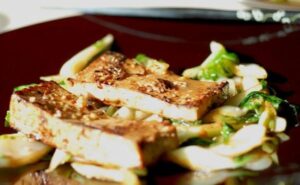Before You Dis It, Find Out: What Is Tofu, Anyhow?

Tofu can be intimidating if you’ve never eaten or cooked with it, but it doesn’t have to be. One of the most popular cooking ingredients in many Asian cuisines, tofu has a long history and, thanks to its stout nutritional profile and versatile nature, will no doubt have a long future as well. Get with the program and take advantage of this low calorie, high protein food and watch your cooking horizons expand.
Tofu has been around for ages and originated in ancient China sometime around 100-200 BCE. The new food and its production technique quickly spread to Korea and then Japan, coinciding with the spread of the Buddhist religion, which often requires a vegetarian diet.
Also called bean curd, tofu is made by coagulating soymilk and then pressing the resulting “curds” together into soft white blocks of varying consistencies. Coagulation or curdling is achieved by adding salts or acids, some of which impart additional nutritional qualities to the tofu. The coagulating salt calcium sulfate creates tofu that is rich in calcium, while the acid coagulant glucono delta-lactone produces silken tofu with a very soft texture.
Tofu can be sold fresh or processed in some way; for example marinated in various oils, herbs or spices. The softest tofu can be used in smoothies and cream sauces, while the firmest types are cut into small chunks and sautéed in all sorts of dishes. With a subtle flavor that does not overpower other ingredients but rather soaks up and enhances their taste, tofu can be used in a range of both sweet and savory dishes.
Fresh tofu comes in three varieties: soft or silken (with the highest moisture content), firm tofu (still moist but firm, like a custard) and Chinese dry tofu, which has the lowest moisture content of all (but isn’t actually dry). At your local grocery store, you will likely encounter the first two varieties.
Tofu is low in calories and fat but very high in protein and iron, making it a mainstay for healthy eaters, especially those on vegetarian diets who need alternatives to meat. With over 10 grams of protein per half-cup serving, tofu is a staple food for many people all over the world.
Tofu beginners may want to start with soft or silken tofu, adding it to sauces, salad dressings, smoothies and desserts to create a thick and creamy texture. Soft tofu doesn’t need to have the water pressed out before use, but be sure to submerge any unused tofu in water in a tightly closed container and refrigerate up to one week.
Firm tofu is packed in water that must be drained before use. It retains its shape much better than soft tofu and works well in dishes such as stir-fries, scrambles and tofu bakes. Add small chunks of tofu to your favorite stir-fried dishes along with your meats or vegetables and it will soak up the flavors that are already present. Cook crumbled tofu in oil with onions and peppers for a quick vegan breakfast scramble, or add small chunks to your favorite stew for an added protein blast.
Once you start working with tofu, you will appreciate its versatility and will be amazed at everything you can do with a little coagulated soymilk. Get started here: 2 Recipes to Infuse Your ‘Fu With Flavor, Tofu that Is.
image: Helga’s Lobster Stew

